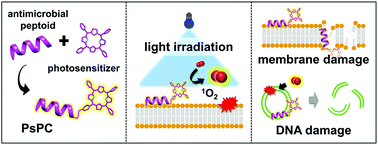Multitarget engagement is considered an effective strategy to overcome the threat of bacterial infection, and antimicrobials with multiple mechanisms of action have been successful as natural chemical weaponry. Here, we synthesized a library of photosensitizer-peptoid conjugates (PsPCs) as novel antimicrobial photodynamic therapy (aPDT) agents. The peptoids, linkers, and photosensitizers were varied, and their structure-antimicrobial activity relationships against Escherichia coli were evaluated; PsPC 9 was indicated to be the most promising photoresponsive antimicrobial agent among the synthesized PsPCs. Spectroscopic analyses indicated that 9 generated singlet oxygen upon absorption of visible light (420 nm) while maintaining the weakly helical conformation of the peptoid. Mechanistic studies suggested that damage to the bacterial membrane and cleavage of DNA upon light irradiation were the main causes of bactericidal activity, which was supported by flow cytometry and DNA gel electrophoresis experiments. We demonstrated that the optimal combination of membrane-active peptoids and photosensitizers can generate an efficient aPDT agent that targets multiple sites of bacterial components and kills bacteria by membrane disruption and reactive oxygen species generation.

